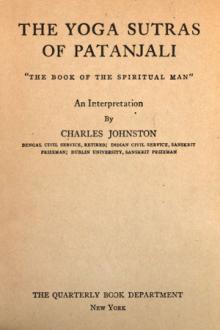An Introduction to Yoga, Annie Besant [good books to read for 12 year olds .txt] 📗

- Author: Annie Besant
- Performer: 8170590507
Book online «An Introduction to Yoga, Annie Besant [good books to read for 12 year olds .txt] 📗». Author Annie Besant
That relation alone it is which makes matter cognizable; the change in the thinker is answered by a change outside, and his answer to it and the change in it that he makes by his. answer re-arrange again the matter of the body which is his envelope.
Hence the rhythmic changes in matter are rightly called its cognizability. Matter may be known by consciousness, because of this unchanging relation between the two sides of the manifest LOGOS who is one, and the Self becomes aware of changes within himself, and thus of those of the external words to which those changes are related.
Mind
What is mind ? From the yogic standpoint it is simply the individualized consciousness, the whole of it, the whole of your consciousness including your activities which the Western psychologist puts outside mind. Only on the basis of Eastern psychology is Yoga possible. How shall we describe this individualized consciousness? First, it is aware of things.
Becoming aware of them, it desires them. Desiring them, it tries to attain them. So we have the three aspects of consciousness—
intelligence, desire, activity. On the physical plane, activity predominates, although desire and thought are present. On the astral plane, desire predominates, and thought and activity are subject to desire. On the mental plane; intelligence is the dominant note, desire and activity are subject to it. Go to the buddhic plane, and cognition, as pure reason, predominates, and so on. Each quality is present all the time, but one predominates. So with the matter that belongs to them. In your combinations of matter you get rhythmic, active, or stable ones; and according to the combinations of matter in your bodies will be the conditions of the activity of the whole of these in consciousness. To practice Yoga you must build your bodies of the rhythmic combinations, with activity and inertia less apparent.
The yogi wants to make his body match his mind.
Stages of Mind
The mind has five stages, Patanjali tells us, and Vyasa comments that “these stages of mind are on every plane”. The first stage is the stage in which the mind is flung about, the Kshipta stage; it is the butterfly mind, the early stage of humanity, or, in man, the mind of the child, darting constantly from one object to another. It corresponds to activity on the physical plane. The next is the confused stage, Mudha, equivalent to the stage of the youth, swayed by emotions, bewildered by them; he begins to feel he is ignorant—a state beyond the fickleness of the child—a characteristic state, corresponding to activity in the astral world. Then comes the state of preoccupation, or infatuation, Vikshipta, the state of the man possessed by an idea—love, ambition, or what not. He is no longer a confused youth, but a man with a clear aim, and an idea possesses him. It may be either the fixed idea of the madman, or the fixed idea which makes the hero or the saint; but in any case he is possessed by the idea.
The quality of the idea, its truth or falsehood, makes the difference between the maniac and the martyr.
Maniac or martyr, he is under the spell of a fixed idea. No reasoning avails against it. If he has assured himself that he is made of glass, no amount of argument will convince him to the contrary. He will always regard himself as being as brittle as glass. That is a fixed idea which is false. But there is a fixed idea which makes the hero and the martyr. For some great truth dearer than life is everything thrown aside. He is possessed by it, dominated by it, and he goes to death gladly for it. That state is said to be approaching Yoga, for such a man is becoming concentrated, even if only possessed by one idea. This stage corresponds to activity on the lower mental plane. Where the man possesses the idea, instead of being possessed by it, that onepointed state of the mind, called Ekagrata in Sanskrit, is the fourth stage. He is a mature man, ready for the true life.
When the man has gone through life dominated by one idea, then he is approaching Yoga; he is getting rid of the grip of the world, and is beyond its allurements. But when he possesses that which before possessed him, then he has become fit for Yoga, and begins the training which makes his progress rapid. This stage corresponds to activity on the higher mental plane.
Out of this fourth stage or Ekagrata, arises the fifth stage, Niruddha or Self-controlled. When the man not only possesses one idea but, rising above all ideas, chooses as he wills, takes or does not take according to the illumined Will, then he is Self-controlled and can effectively practice Yoga. This stage corresponds to activity on the buddhic plane.
In the third stage, Vikshipta, where he is possessed by the idea, he is learning Viveka or discrimination between the outer and the inner, the real and the unreal. When he has learned the lesson of Viveka, then he advances a stage forward; and in Ekagrata he chooses one idea, the inner life; and as he fixes his mind on that idea he learns Vairagya or dispassion. He rises above the desire to possess objects of enjoyment, belonging either to this or any other world. Then he advances towards the fifth stage—
Self-controlled. In order to reach that he must practice the six endowments, the Shatsamapatti. These six endowments have to do with the Will-aspect of consciousness as the other two, Viveka and Vairagya, have to do with the cognition and activity aspects of it.
By a study of your own mind, you can find out how far you are ready to begin the definite practice of Yoga. Examine your mind in order to recognize these stages in yourself. If you are in either of the two early stages, you are not ready for Yoga. The child and the youth are not ready to become yogis, nor is the preoccupied man. But if you find yourself possessed by a single thought, you are nearly ready for Yoga; it leads to the next stage of onepointedness, where you can choose your idea, and cling to it of your own will. Short is the step from that to the complete control, which can inhibit all motions of the mind.
Having reached that stage, it is comparatively easy to pass into Samadhi.
Inward and Outward-Turned Consciousness Samadhi is of two kinds: one turned outward, one turned inward.
The outward-turned consciousness is always first. You are in the stage of Samadhi belonging to the outward-turned waking consciousness, when you can pass beyond the objects to the principles which those objects manifest, when through the form you catch a glimpse of the life. Darwin was in this stage when he glimpsed the truth of evolution. That is the outward-turned Samadhi of the physical body.
This is technically the Samprajnata Samadhi, the “Samadhi with consciousness,” but to be better regarded, I think, as with consciousness outward-turned, i.e. conscious of objects. When the object disappears, that is, when consciousness draws itself away from the sheath by which those objects are seen, then comes the Asamprajnata Samadhi; called the “Samadhi without consciousness”.
I prefer to call it the inward-turned consciousness, as it is by turning away from the outer that this stage is reached.
These two stages of Samadhi follow each other on every plane; the intense concentration on objects in the first stage, and the piercing thereby through the outer form to the underlying principle, are followed by the turning away of the consciousness from the sheath which has served its purpose, and its withdrawal into itself, i.e., into a sheath not yet recognised as a sheath.
It is then for a while conscious only of itself and not of the outer world. Then comes the “cloud,” the dawning sense again of an outer, a dim sensing of “something” other than itself; that again is followed by the functioning of the nigher sheath and the Recognition of the objects of the next higher plane, corresponding to that sheath. Hence the complete cycle is: Samprajnata Samadhi, Asamprajnata Samadhi, Megha (cloud), and then the Samprajnata Samadhi of the next plane, and so on.
The Cloud
This term—in full, Dharma-megha, cloud of righteousness, or of religion—is one which is very scantily explained by the commentators. In fact, the only explanation they give is that all the man’s past karma of good gathers over him, and pours down upon him a rain of blessing. Let us see if we cannot find something more than this meagre interpretation.
The term “cloud” is very often used in mystic literature of the West; the “Cloud on the Mount,” the “Cloud on the Sanctuary,” the “Cloud on the Mercy-Seat,” are expressions familiar to the student. And the experience which they indicate is familiar to all mystics in its lower phases, and to some in its fullness. In its lower phases, it is the experience just noted, where the withdrawal of the consciousness into a sheath not yet recognised as a sheath is followed by the beginning of the functioning of that sheath, the first indication of which is the dim sensing of an outer. You feel as though surrounded by a dense mist, conscious that you are not alone but unable to see. Be still; be patient; wait. Let your consciousness be in the attitude of suspense. Presently the cloud will thin, and first in glimpses, then in its full beauty, the vision of a higher plane will dawn on your entranced sight. This entrance into a higher plane will repeat itself again and again, until your consciousness, centred on the buddhic plane and its splendouis having disappeared as your consciousness withdraws even from that exquisite sheath, you find yourself in the true cloud, the cloud on the sanctuary, the cloud that veils the Holiest, that hides the vision of the Self.
Then comes what seems to be the draining away of the very life, the letting go of the last hold on the tangible, the hanging in a void, the horror of great darkness, loneliness unspeakable.
Endure, endure. Everything must go. “Nothing out of the Eternal can help you.” God only shines out in the stillness; as says the Hebrew: “Be still, and know that I am God.” In that silence a Voice shall be heard, the voice of the Self, In that stillness a Life shall be felt, the life of the Self. In that void a Fullness shall be revealed, the fullness of the Self. In that darkness a Light shall be seen, the glory of the Self. The cloud shall vanish, and the shining of the Self shall be made manifest. That which was a glimpse of a far-off majesty shall become a perpetual realisation and, knowing the Self and your unity with it, you shall enter into the Peace that belongs to the Self alone.
Lecture II
SCHOOLS OF THOUGHT
In studying psychology anyone who is acquainted with the Sanskrit tongue must know how valuable that language is for precise and scientific dealing with the subject. The Sanskrit, or the well-made, the constructed, the built-together, tongue, is





Comments (0)